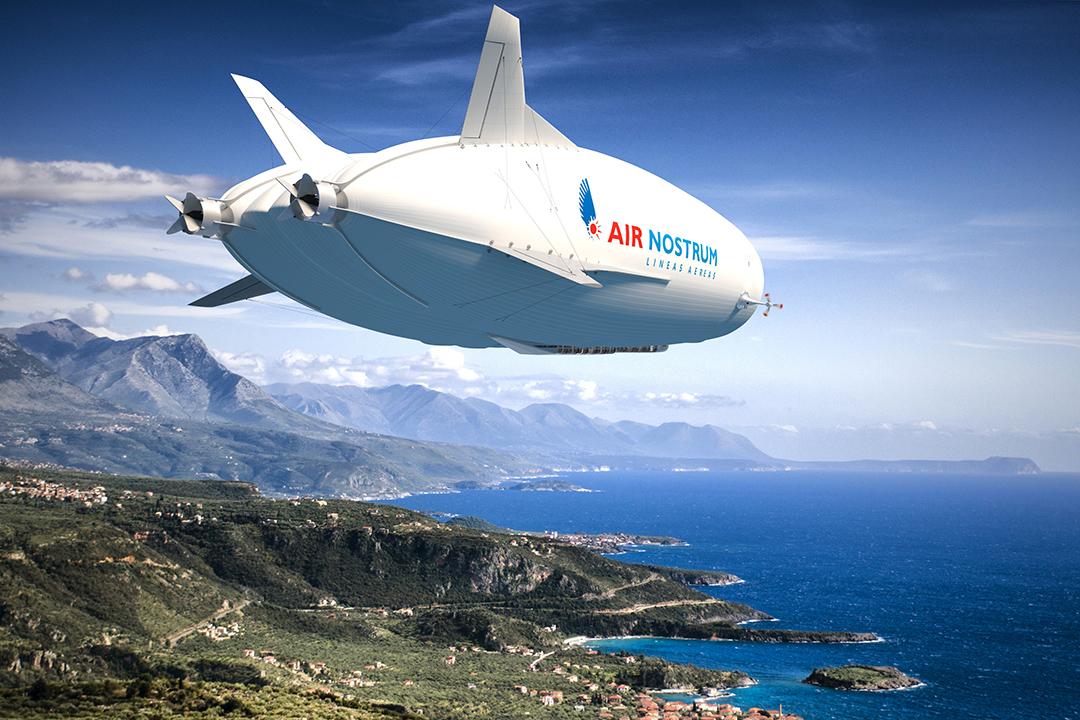Air Nostrum Reserves Airlander 10 Hybrid Airships For Domestic Flights

Spanish regional airline Air Nostrum has signed an agreement with Hybrid Air Vehicles (HAV) that would see it become the launch customer for the British airframer’s Airlander 10 hybrid airship.
The deal, valued by HAV as potentially in excess of $600 million, gives Air Nostrum the option of receiving up to 10 of the 100-seat aircraft. Deliveries to Air Nostrum are scheduled to begin from 2026. The airline, which operates regional flights for Iberia, intends to operate the aircraft on domestic routes in Spain.
The deal is described as a “reservation agreement” and allows for a firm contract to be concluded subsequently, Aviation Week understands. There are no express conditions attached or milestones specified, though the company will be expected to deliver a type-certified aircraft.
Work on the first production Airlander 10 will begin before the end of 2022, HAV says, at a new as-yet-unidentified production facility to be established near Doncaster, England. The production version has its first flight scheduled for 2023.
“We are exploring each and every possible way to reduce our carbon footprint,” says Air Nostrum president Carlos Bertomeu. “The Airlander 10 will drastically reduce emissions.” The “reservation agreement” follows six months of rigorous studies into Airlander 10 operations on Spanish domestic routes. The two parties first began collaborating in June 2021.
The companies say that Airlander 10 will produce around one-tenth of the emissions that would otherwise be produced by carrying 100 passengers on the same route using existing aircraft.
Air Nostrum—which currently operates ATR 72s and CRJs—would take delivery of the 10 Airlanders over a five-year period.
Greater in size than a Boeing 747, HAV says the Airlander 10 will be the world’s first large-scale aircraft—capable of carrying up to 100 passengers or 10 metric tonnes (22,000 lb.)—to achieve zero-emissions flight. The company was originally anticipating Airlander 10 certification in 2018.
In January 2022, EASA published its SC GAS—Special Condition for Gas Airships—which offers a route to certification for aircraft such as Airlander 10. Since the beginning of 2021, when the UK left the EU, the UK Civil Aviation Authority has become HAV’s certifying authority. In a February statement, the company said it “intend[s] to propose to the CAA and other regulators around the world that they adopt SC GAS as their certification basis.”
According to HAV’s website, the Airlander 10 has an endurance of up to 4,000 nm and can spend up to five days airborne, with a maximum altitude of 20,000 ft. The partners said that the Airlander 10 can land on “any reasonably flat surface,” both on land and in water. It can also take off and land in small spaces, such as islands, without the need for airport facilities.
The Airlander 10 originated in a U.S. Army program for a long-endurance, multi-intelligence vehicle (LEMV), which was intended to provide surveillance over areas such as Afghanistan. The LEMV project was terminated in early 2013 as part of U.S. budget cuts. HAV bought back the vehicle for just over $300,000 after the U.S. had spent some $150 million on the project.
However, the Airlander 10 project experienced a setback early on in its development in 2016, when a prototype was damaged in a heavy landing on its second test flight in the UK. There were no injuries in the incident.
Unlike earlier airships, the Airlander’s shape effectively makes it a flying wing. The pilot sits at the front of the under-vehicle cabin, with the passenger or payload area located behind the pilot.
Production Site Search
“This agreement enhances the possibility of the revolutionary, British-made and designed, Airlander 10 aircraft flying across Spanish skies,” said Kwasi Kwarteng, the UK secretary of state for business, energy and industrial strategy. “Hybrid aircraft could play an important role as we transition to cleaner forms of aviation, and it is wonderful to see the UK right at the forefront of the technology’s development.”
HAV has been in “advanced discussions” with the South Yorkshire Mayoral Combined Authority (SYMCA), Doncaster Council and others over the proposed new facility since January. In October 2021, HAV announced a teaming agreement with the University of Sheffield’s Advanced Manufacturing Research Center, intended to “identify projects developing research, innovation, and training linked to” Airlander 10 production in the region.
“South Yorkshire presents an ideal combination of strategic vision, educational and research institutions, potential partners, and current partners as well as geographical location,” a spokesperson for HAV told Aviation Week. “The brand-new facility is set to create thousands of skilled jobs in green aerospace technologies, supporting leveling up across the region. Together, HAV, SYMCA and these other organizations have built a strong relationship and HAV is set to continue to establish Airlander 10’s production home in South Yorkshire.”
The company says there are “currently several candidate sites near Doncaster” where the facility could be built. No date has been set by which construction will begin, though HAV has been taking part in careers fairs across northern England as it prepares to launch a recruitment drive.



Comments